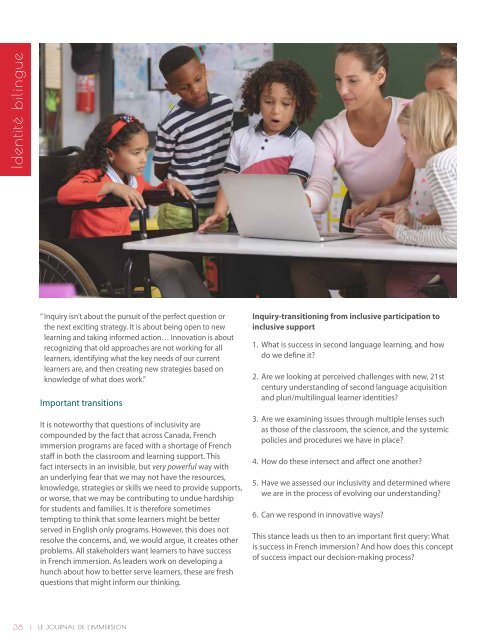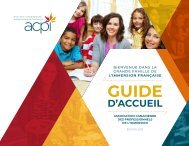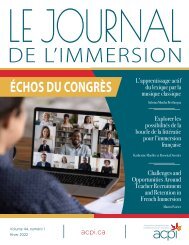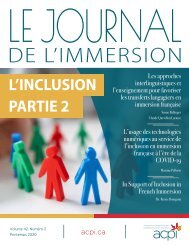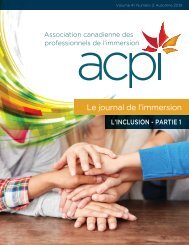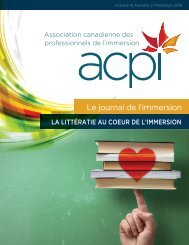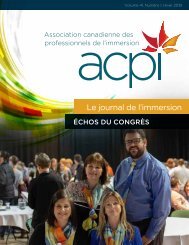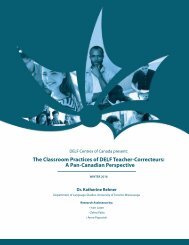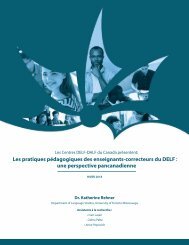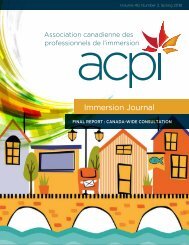Vol_43_n2_web_f
You also want an ePaper? Increase the reach of your titles
YUMPU automatically turns print PDFs into web optimized ePapers that Google loves.
Identité bilingue<br />
The bilingual learner: success<br />
Reinterpreting multilanguage learner behaviours<br />
Identité bilingue<br />
“ Inquiry isn’t about the pursuit of the perfect question or<br />
the next exciting strategy. It is about being open to new<br />
learning and taking informed action… Innovation is about<br />
recognizing that old approaches are not working for all<br />
learners, identifying what the key needs of our current<br />
learners are, and then creating new strategies based on<br />
knowledge of what does work.”<br />
Important transitions<br />
It is noteworthy that questions of inclusivity are<br />
compounded by the fact that across Canada, French<br />
immersion programs are faced with a shortage of French<br />
staff in both the classroom and learning support. This<br />
fact intersects in an invisible, but very powerful way with<br />
an underlying fear that we may not have the resources,<br />
knowledge, strategies or skills we need to provide supports,<br />
or worse, that we may be contributing to undue hardship<br />
for students and families. It is therefore sometimes<br />
tempting to think that some learners might be better<br />
served in English only programs. However, this does not<br />
resolve the concerns, and, we would argue, it creates other<br />
problems. All stakeholders want learners to have success<br />
in French immersion. As leaders work on developing a<br />
hunch about how to better serve learners, these are fresh<br />
questions that might inform our thinking.<br />
Inquiry-transitioning from inclusive participation to<br />
inclusive support<br />
1. What is success in second language learning, and how<br />
do we define it?<br />
2. Are we looking at perceived challenges with new, 21st<br />
century understanding of second language acquisition<br />
and pluri/multilingual learner identities?<br />
3. Are we examining issues through multiple lenses such<br />
as those of the classroom, the science, and the systemic<br />
policies and procedures we have in place?<br />
4. How do these intersect and affect one another?<br />
5. Have we assessed our inclusivity and determined where<br />
we are in the process of evolving our understanding?<br />
6. Can we respond in innovative ways?<br />
This stance leads us then to an important first query: What<br />
is success in French immersion? And how does this concept<br />
of success impact our decision-making process?<br />
We are beginning to explore if our understanding of<br />
success in French immersion may sometimes be rooted<br />
in myths about other language learners, misconceptions<br />
of bilingualism, misinterpretation of learner data, or an<br />
insufficient valuation of additional language learning. It<br />
is only recently that we have begun to have research to<br />
inform our thinking.<br />
Renée Bourgoin and Katy Arnett provide an excellent<br />
summary of these myths, and give us an opportunity to<br />
reflect on how these may influence our practices (Arnett<br />
& Bourgoin, 2018). Their summary might serve to initiate<br />
conversations in our jurisdictions about which myths may<br />
be casting a shadow on our practices and procedures.<br />
The confused learner: bilingualism and native like<br />
proficiency<br />
Sometimes, students present with differing skills in<br />
the languages being learned. The teacher may note,<br />
for example, that the student’s writing in English<br />
exceeds that in French. Errors and significant differences<br />
between the two languages may cause teachers and<br />
parents to be concerned. But this perception of the<br />
discrepancy as problematic may be rooted in a pervasive<br />
misunderstanding of what bilingual education should<br />
achieve.<br />
This old belief that bilingualism should yield the<br />
SAME results in both languages is simply not borne<br />
out by the science of second language acquisition.<br />
Not only do most learners show differences in<br />
proficiency between the languages being learned,<br />
but in fact, even within the same language.<br />
It is quite common, for example, for a native speaker of<br />
English to have strong oral skills but have less developed<br />
writing skills. It is a false conception that effective bilingual<br />
education yields the skill levels of a “monolingual plus<br />
monolingual.” Research has consistently borne witness<br />
that only a very few people ever achieve this level of equal<br />
performance in both languages (Grosjean, 2002).<br />
It is part of the bilingual learner profile and identity that<br />
additional language learners exhibit differing levels of<br />
competency both within and between languages. The<br />
CEFR portfolio self-assessment can be a useful tool for us<br />
to explore this for ourselves (Council of Europe, 2021). It<br />
can help us see and understand our own varying levels of<br />
competencies in our own language.<br />
Code switching<br />
Another area worthy of exploration is our perceptions<br />
of multilingual language learning behaviours. When we<br />
understand the nature of multilingual students and their<br />
behaviours, we begin to recognize that many of their<br />
behaviours may be misperceived as errors. It may be<br />
worthwhile to revisit some features of bilingual learners<br />
with personnel who have not had an opportunity<br />
to explore second language learning so they better<br />
understand and interpret some learner behaviours that<br />
might seem unusual.<br />
A very common example is “code switching”. This involves<br />
the capacity to move from one language to the other very<br />
rapidly, and sometimes in the same sentence. Viewed<br />
through the eyes of a monolingual speaker, this can appear<br />
as an error (Cook, 2009). For example, a student might<br />
say: « Oh non! J’ai oublié mon lunch bag à la maison! »<br />
It is possible that the student has weak vocabulary and<br />
does not know the French word. But it is also possible that<br />
this word is the first one to surface in their vocabulary<br />
bank because, as they visualize their lunch bag sitting on<br />
their counter in their English-speaking home, this context<br />
makes the English word the first one readily available.<br />
However, it remains important to know how to discern<br />
a genuine lack of vocabulary from code switching. This<br />
common but complex skill is a part of the typical bilingual<br />
learner profile.<br />
Additional language learners mixing up letters and sounds<br />
Another area that sometimes creates concern about<br />
young learners, is when students appear to mix up letters<br />
and sounds. For example, a student in immersion may<br />
say the letter name “Ee” when referring to French letter<br />
“E”. Bilingual children are learning to encode two sound<br />
systems with overlapping and sometimes conflicting<br />
information. It may come as a relief to know that this<br />
is normal and to be expected as part of the evolution<br />
of learning and managing two language databases.<br />
Anticipating this pattern allows us to be proactive and<br />
to strategically collaborate to address this. Having ELL<br />
and FSL teachers, for example, collaborate on how and<br />
when to explicitly teach these letters would benefit both<br />
their French and ELL programming. Exploring practices<br />
such as “teaching for transfer” (Mady & Thomas, 2014)<br />
provide useful ideas that enable us to break out of silos<br />
and find meaningful ways of creating explicit links that<br />
help children learn about both languages in mutually<br />
reinforcing ways.<br />
38 | LE JOURNAL DE L'IMMERSION<br />
<strong>Vol</strong>. <strong>43</strong>, n o 2, été 2021 | 39


